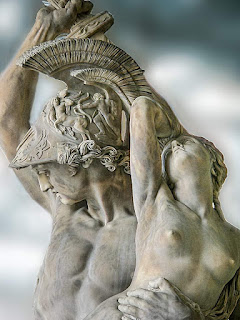Another statue in the Loggia dei Lanzi in Florence is the so-called
Another statue in the Loggia dei Lanzi in Florence is the so-called Rape of Polyxena by Pio Fedi produced between 1855 and 1865. Classically speaking, however, it is not accurate to the original myth.
Polyxena is considered the Trojan version of Iphigenia, daughter of Agamemnon and Clytemnestra. She is not in Homer's Iliad, appearing in works by later poets, perhaps to add romance to Homer's austere tale.
During the Trojan War, Polyxena and Troilus were ambushed when they were attempting to fetch water from a fountain, and Troilus was killed by the Greek warrior Achilles, who soon became interested in the quiet sagacity of Polyxena. Achilles, still recovering from Patroclus' death, found Polyxena's words a comfort and was later told to go to the temple of Apollo to meet her after her devotions. Achilles seemed to trust Polyxena—he told her of his only vulnerability: his vulnerable heel.
It was later in the temple of Apollo that Polyxena's brothers, Paris and Deiphobus, ambushed Achilles and shot him in the heel with an arrow, supposedly guided by the hand of Apollo himself, steeped in poison.
Some claimed Polyxena committed suicide after Achilles' death out of guilt. According to Euripides, however, in his plays The Trojan Women and Hecuba, Polyxena's famous death was caused at the end of the Trojan War. Achilles' ghost had come back to the Greeks to demand the human sacrifice of Polyxena so as to appease the gods and provide the wind needed to set sail back to Hellas. Polyxena's virginity was critical to the honor of her character, and she was described as dying bravely as the son of Achilles, Neoptolemus, slit her throat. There was no rape involved.
I was looking through my images of the sculpture by Fedi and came across a closeup that I had never shared online before. When I was in Florence in 2005, the Uffitzi was doing some repair work and there was a rather unsightly framework of piping in the Loggia dei Lanzi and it appeared in the background of my closeup. So, for those of you interested in photography and image editing, I selected the background and rendered just enough Gaussian blur in Photoshop to obscure the framework. Then I also had a problem that Neoptolemus was heavily shadowed. I reduced the shadow as much as I could using Adobe Camera Raw then opened the image in ON1 Photo Raw, added dynamic contrast to enhance the texture then "painted" with light using the local effects palette to improve the light balance between Neoptolemus and Polyxena. To finish it off I used Topaz Labs' Studio 2 Glow filter with the Bloom preset at 22 percent to soften the edges just enough to make them blend more naturally into the blurred background.



Comments
Post a Comment